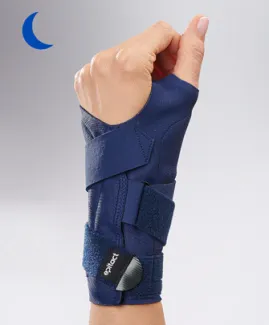
There are several causes of wrist pain from golfing. In addition to injuries caused by intensive golf practice, conditions that affect the joints and tendons are also common. First, EPITACT®identifies the most common golf wrist injuries and their causes. Then, we tell you how to prevent and relieve them thanks to wrist supports and braces!
The risk factors of wrist pain in golf
The origin of golf injuries of the wrist is multifactorial. There are also many risk factors like the equipment, the presence of potential obstacles on the ground or during the golf swing or the technique and posture of the player.
To be more precise, there are several ways of gripping the golf club and some types of grip can have consequences on the position and comfort of the golfer. In any case, adopting the correct posture is crucial as it enables you to handle the club weight easily and support the force of the impact combined with the hitting power.
Causes of wrist injuries in golfers
Among the common golf wrist injuries, traumatic conditions take the lead. They are caused by a shock that consequently causes an injury.
It can be bone lesions like fractures (fatigue fractures of the metacarpal bones or triquetrum, ulna, scaphoid or process of the hamate bone).
Other wrist pain from golfing are due to tendon injuries and are part of the recurrent risks of traumas (e.g.: dislocation of the extensor carpi ulnaris).
Lastly, the third type of wrist injuries in golf is ligament lesions which especially affect the triangular fibrocartilage complex. Other examples are sprained wrists and fingers like those affecting the metacarpophalangeal joint of the index finger, the radiocarpal joint or the interphalangeal joints of the fingers.
Golf pain of the wrist affecting the joints
The practice of golf can also damage the joints within the wrist. The wrist is a complex part of the body made of multiple joints exposed to a number of potential injuries. For example, a separation of the carpal bones or painful synovial cysts can impact the golfer’s performances on the green.
Among the most common wrist injuries on the golf course, let’s name thumb arthritis or thumb osteoarthritis. It corresponds to the wear and tear of the cartilage at the base of the thumb (trapeziometacarpal joint) which gets worse over time and progressively impacts prehension. Grabbing small objects, holding objects over a prolonged period of time or doing twisting movements can create discomfort.
This condition causes the deformity of the thumb preceded by some warning signals like joint cracking or swelling. To prevent or fight these symptoms, EPITACT® has developed two thumb support braces.
The first one is recommended during the day to increase your comfort during daily activities like on the golf course. The second one is for rest and night and immobilises the thumb in a neutral position.
Golf injuries of the wrist affecting the tendons
Nerves and tendons that pass through the wrist are also likely to be affected… Focus on the common wrist injuries in recreational and professional golfers!
Carpal tunnel syndrome is a common cause of wrist pain in golf
Carpal tunnel syndrome (CTS) is the compression of the median nerve in the carpal tunnel. As a result, the fingers (thumb, index, middle and half of the ring finger) are less innervated and they lose sensitivity. Indeed, one of the specific symptoms of carpal tunnel syndrome is tingling in the hand, wrist and fingers.
Unsurprisingly, CTS can disrupt the way the golfer grips the golf club, not to mention the impact on performances! Let’s also remember that women are more prone to this syndrome than men because they have naturally narrower wrists.
To limit the pressure on the carpal tunnel and so the related symptoms, EPITACT® has created two wrist support braces. The day wrist support CARP’ACTIV™* preserves mobility of the wrist but while it limits traumatic movements. To decrease the symptoms also at rest, the night wrist brace CARP’IMMO™* places your joint in a resting position to avoid pressure on the painful area.
Golf pain in the wrist caused by De Quervain’s tenosynovitis
Golfers are also exposed to the risk of developing De Quervain’s tenosynovitis, also called thumb tendonitis. Why? Purely and simply because golf involves intense and repetitive motion of the wrist and thumb of the guiding hand. This injury is mainly due to thumb motion during rotation of the chest.
Fortunately, thumb and wrist braces relieve intense pain felt in the case of De Quervain’s tenosynovitis. Wearing this type of braces can be associated with non-steroidal anti-inflammatory medication. They are prescribed after consultation with a general practitioner or sports physician.
In the case of persistent pain, make an appointment with another specialist like an orthopaedic surgeon. Therefore, cortisone injections or surgery as a last resort could be considered.
De Quervain’s tenosynovitis is not the only type of tendonitis that affects a golf professional or an amateur. There are also tenosynovitis of the extensor carpi ulnari, of the extensor tendons and flexor tendons (of the index finger or ring finger). Other causes of wrist pain from golfing like intersection syndrome or enthesopathy of the radius can even lead to temporary stop of the sport activity.
Golfers can be afflicted with painful wrist injuries, but preventing them is possible! Limit as much as possible the risks by doing regular warm-up, muscle strengthening and stretching exercises. You can also rely on braces to relieve your thumb or wrist pain during golf. To get the right diagnosis and treatment, always see a health professional.
*These solutions are class I medical devices that bear the CE marking under this regulation. Carefully read the instructions before use. Manufacturer: Millet Innovation. 07/2023
 Pharmacie
Pharmacie

